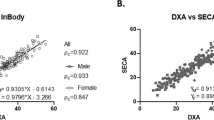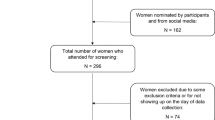Abstract
Objective: The aim of the study was to investigate whether there is a difference between body fat mass percentage measured by BIA and DXA method.
Design: Transversal study, randomized.
Setting: Lipid and Obesity Outpatient Clinic, Department of Pediatrics, University of Vienna, Austria.
Subjects: Twenty-seven children and adolescents from the Lipid and Obesity Outpatient Clinic, Department of Pediatrics, University of Vienna, were included in the study (14 boys and 13 girls between 6 and 18 y; mean age 12.6 and 13.1 y).
Methods: The body fat percentage was measured with BIA (bioelectrical impedance analyzer BIA 2000-M) and DXA (dual energy X-ray absorptiometry) methods on the same day.
Results: The mean difference between the body fat mass percentage measured by BIA and DXA was 4.48 with a standard deviation of 2.93. The results measured by BIA were almost always lower than that by DXA by about 12%. The lower and upper limit of the difference in 95% confidence interval was −5.64 and −3.32. By paired t-test, these results were significantly different (P<0.001). The correlation between the two measurements was 0.826. The mean percentage of body fat mass measured by BIA was 34.86±7.08% and by DXA 39.75±5.63%. The differences were not changed by age and body fat percentage but they were by sex.
Conclusions: The results of the study show that the body fat percentages measured by BIA and DXA method were significantly different. This is very important because BIA technique is a routine technique for clinical purposes. Adjustments to the formula used for calculating the total fat mass in obese children and adolescence are necessary. Underestimation of body fat percentage measured by bioelectrical impedance analysis compared to dual X-ray absorptiometry method in obese children is three times higher with boys than with girls.
Sponsorship: Data Input GmbH, Hofheim, Germany.
European Journal of Clinical Nutrition (2001) 55, 423–429
This is a preview of subscription content, access via your institution
Access options
Subscribe to this journal
Receive 12 print issues and online access
$259.00 per year
only $21.58 per issue
Buy this article
- Purchase on Springer Link
- Instant access to full article PDF
Prices may be subject to local taxes which are calculated during checkout
Similar content being viewed by others
References
Bland JM & Altman DG (1986) Statistical methods for assessing agreement between two methods of clinical measurement Lancet i 307–310
Data Input GmbH (1998) BIA-Kompendium. Biophysikalische Grundlagen, Körperzusammensetzung, Ernährungszustand, Klinische Anwendungsbereiche, Fallbeispiele Hofheim, Germany
Deurenberg P (1996) Limitations of the bioelectrical impedance method for the assessment of body fat in severe obesity Am. J. Clin. Nutr 64(Suppl) 449S–452S
Dezenberg CV, Nagy TR, Gower BA, Johnson R Goran MI (1999) Predicting body composition from anthropometry in pre-adolescent children Int. J. Obes. Relat. Metab. Disord 23 253–259
Ellis KJ (1996) Measuring body fatness in children and young adults: comparison of bioelectric impedance analysis, total body electrical conductivity, and dual-energy X-ray absorptiometry Int. J. Obes. Relat. Metab. Disord 20 866–873
Fischer H & Lembcke B (1991) Die Anwendung der Bioelektrischen Impedananalyse (BIA) zur Beurteilung der Körperzusammensetzung und des Ernährungszustandes Innere Medizin Aktuell 18(1/1991) S13–S17
Fusch C et al (1999) Neonatal body composition: dual energy X-ray absorptiometry, magnetic resonance imaging, and three-dimensional chemical shift imaging versus chemical analysis in piglets Pediatr. Res 46 465–473
Heber D, Ingles S, Ashley JM, Maxwell MH, Lyons RF & Elashoff RM (1996) Clinical detection of sarcopenic obesity by bioelectrical impedance analysis Am. J. Clin. Nutr 64 472S–477S
Kushner RF & Schoeller DA (1986) Estimation of total body water by bioelectrical impedance analysis Am. J. Clin. Nutr 44 417–424
Levenhagen DK, Borel MJ, Welch DC, Piasecki JH, Chen KY & Flakoll PJ (1999) A comparison of air displacement plethysmography with three other techniques to determine body fat in healthy adults J. Parent. Enteral. Nutr 23 293–299
Lewy VD, Danadian K & Arslanian S (1999) Determination of body composition in African-American children: validation of bioelectrical impedance with dual energy X-ray absorptiometry J. Pediatr. Endocrinol. Metab 12 443–448
Lukaski HC (1987) Methods for the assessment of human body composition: traditional and new Am. J. Clin. Nutr 46 537–556
Okasora K, Takaya R, Tokuda M, Fukunaga Y, Oguni T, Tanaka H, Konishi K & Tamani H (1999) Comparison of bioelectrical impedance analysis and dual energy X-ray absorptiometry for assessment of body composition in children Pediatr. Int 41 121–125
Pietrobelli A, Wang ZM & Heymsfied SB (1998) Techniques used in measuring human body composition Curr. Opin. Clin. Nutr. Metab. Care 1 439–448
Rodriguez G, Moreno LA, Sarria A, Fleta J & Bueno M (1999) Diurnal variation in the assessment of body composition using bioelectrical impedance in children Eur. J. Clin. Nutr 53 24 4
Schoeller DA (1989) Changes in total-body water with age Am. J. Clin. Nutr 50 117 6
Segal KR, Burastero S, Chun A, Coronel P, Pierson RN & Wang J (1991) Estimation of extracellular and total body water by multiple-frequency bioelectrical impedance measurement Am. J. Clin. Nutr 54 26–29
Wattanapenpaiboon N, Lukito W, Strauss BJG, Hsu-Hage BH-H, Wahlqvist ML & Stroud DP (1998) Agreement of skinfold measurement and bioelectrical impedance analysis (BIA) methods with dual energy X-ray absorptiometry (DEXA) in estimating total body fat in Anglo-Celtic Australians Int. J. Obes. Relat. Metab. Disord 22 854–860
Author information
Authors and Affiliations
Corresponding author
Rights and permissions
About this article
Cite this article
Eisenkölbl, J., Kartasurya, M. & Widhalm, K. Underestimation of percentage fat mass measured by bioelectrical impedance analysis compared to dual energy X-ray absorptiometry method in obese children. Eur J Clin Nutr 55, 423–429 (2001). https://doi.org/10.1038/sj.ejcn.1601184
Received:
Revised:
Accepted:
Published:
Issue Date:
DOI: https://doi.org/10.1038/sj.ejcn.1601184
Keywords
This article is cited by
-
Fat-free mass prediction equations for bioelectric impedance analysis compared to dual energy X-ray absorptiometry in obese adolescents: a validation study
BMC Pediatrics (2015)
-
Body composition during growth in children: limitations and perspectives of bioelectrical impedance analysis
European Journal of Clinical Nutrition (2015)
-
Low-glycemic index diet may improve insulin sensitivity in obese children
Pediatric Research (2015)
-
Lower limb body composition is associated to knee passive extension torque-angle response
SpringerPlus (2013)
-
Correlations among adiposity measures in school-aged children
BMC Pediatrics (2013)



